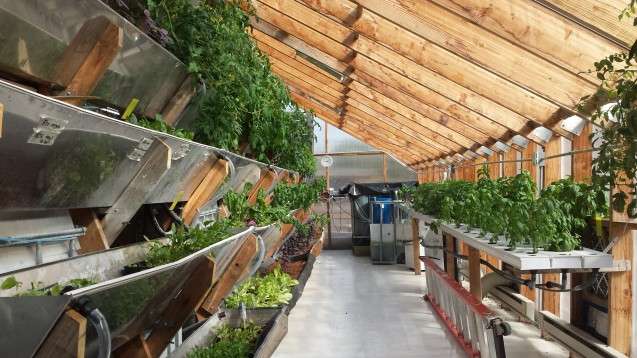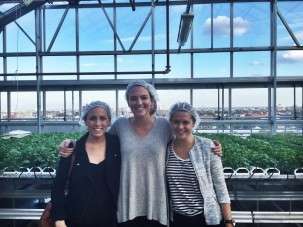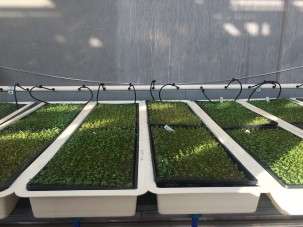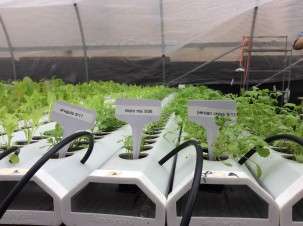How sustainable is vertical farming?

The world's food system is beginning to strain under a global population expected to reach nine billion by 2050, by which time the planet's arable land is projected to be half of what it was in the 1970s. And as climate change threatens long-term food security, agriculture will need to produce 70 percent more food to feed an increasingly crowded world.
Today's agricultural systems are not as efficient or sustainable as they should or could be: Agriculture uses 80 percent of freshwater and produces approximately 24 percent of the world's greenhouse gas emissions; pesticide use causes runoff that pollutes rivers, lakes and oceans.
Moreover, the average item of food travels approximately 1,500 miles before it reaches our plates, resulting in wasted food and more greenhouse gas emissions.
Vertical farming—the growing of crops (up rather than out) in a closed stacked system— is one promising solution to the drawbacks of traditional agriculture. Compared to traditional agriculture, vertical farming uses 70 to 95 percent less water and over 90 percent less land, while harvesting 80 percent more per unit of area. The Association for Vertical Farming, a two-year-old nonprofit focused on advancing the industry, says that vertical farming allows farmers to produce crops all year round because all environmental factors are controlled. It produces healthier and higher yields faster than traditional agriculture, and is resilient to climate change. Moreover as the global population becomes more urbanized, vertical farms can help meet the rising demand for fresh local produce.
There are many kinds of vertical farms, differing in the type and square footage of buildings or rooftops they occupy and the mode of light used (daylight or LEDs). Crops can be grown using hydroponics, in water or a growing medium with nutrients delivered directly to their roots; aeroponics, where a mist delivers nutrients to plant roots; aquaponics, when fish are raised concurrently and their waste is used as nutrients for crops; or even in soil if the building is designed accordingly.
The 44-member, New York City-based Association for Vertical Farming challenged a group of students in Columbia University's Master of Science in Sustainability Management program, who must work in teams with real clients for their final capstone projects, to come up with a certification system to assess the sustainability of vertical farms. Ideally, the certification system would be able to define the criteria for a credits-based sustainability rating of farms, recognize farms operating sustainably, and provide a best practices guide for existing and new farms to become more sustainable.
"The challenge The Association for Vertical Farming is facing is how do you manage the growing industry of vertical farming," said Kiley Miller, one of the project's student managers. "As that growth continues, you need to make sure that these operations are sustainable, and not impacting water resources and energy use. There's a lot of focus on food as a sustainable piece, but not as much on entire farming systems, and operations and management structures. So The Association for Vertical Farming is trying to figure out a way to standardize systems performance across the industry and within the farms, and to identify best practices and benchmarking baselines so it can engage with these farms and ask how can we improve, how can the industry improve as a whole."
Henry Gordon-Smith, vice chair of The Association for Vertical Farming and an alumnus of the Master of Science in Sustainability Management program, said that because vertical farming is a rapidly growing and young industry, it is important to develop a strategy capable of defining its impacts early on. While the benefits of vertical farming seem obvious, its real effects are complex and need to be quantified since they might be subject to greenwashing. For example, "They might be growing a big yield in a small space, but be using a lot of energy to do it and not talking about that," he said. "Or they might be using less water, but it might have nutrients in it that could cause problems for the urban water system."
Susanne DesRoches, the capstone's instructor, who is deputy director of Infrastructure Policy at the New York City Mayor's Office of Recovery and Resiliency, divided her 14 students into two teams. One team was tasked with investigating other certification systems such as LEED, Energy Star and USDA Organic to figure out how established systems do their benchmarking. The other team researched vertical farms in the New York and New Jersey area, visiting nine farms and conducting 17 interviews with growers.

One farm that particularly impressed the students was Sky Vegetables in the Bronx, which is building sustainable, commercial-scale hydroponic farms on urban rooftops across the country.
Based in a LEED building, the Bronx farm grows fresh, chemical-free produce, which it provides to local residents and restaurants, and creates jobs and educational opportunities.
After researching other certification systems to understand the types of systems and frameworks that exist, the students broke them down into various principles and criteria. They considered the feedback from the vertical farms and the main indicators the farms said were important to measure for systems performance. They also looked at what the Food and Agricultural Organization of the United Nations determined were key indicators for a sustainability assessment of food and agriculture systems. Finally, the students settled on nine key principles by which to assess the sustainability of vertical farms.
- Health and safety
- Food safety and quality assurance
- Pest management and pesticide use
- Nutrient management and fertilizer use
- Water conservation and management
- Community relations
- Waste management
- Energy and climate
- Site and facility characteristics.
Within these nine principles are 50 more specific metrics to be measured. The students then tried to figure out how to relate these to the certification systems they had studied to determine what kind of system would work best for the farms.
The big challenge they faced was gathering the systems performance data necessary to establish a baseline of best practices and benchmarking numbers. Several farms had data to offer, but the majority did not. There is not yet enough data available to be able to determine what metrics can or should be considered sustainable—for example, to say definitively that X number of kilowatt-hours of electricity use is considered sustainable for a farm of a particular type or size. And without data and benchmarks, it's impossible to create a certification system.
"Most of the farms are new. Their average age is 6 years old, and they've previously had no incentive to collect this data and track it and record it," said Katie Macdonald, the second student manager. "It's resource intensive, and at these farms there are not many on staff, so it would be costly to do."
Gordon-Smith knew beforehand that there were gaps in the data. "Farms don't want to reveal their costs because it is a competitive business," he said. But he felt it would be valuable to have the students dive in and do the research from scratch, taking a fresh look at what the association might do.

On Dec. 8, Glen Halperin presented the team's findings to The Association for Vertical Farming at the final briefing of the Capstone Workshop.
The students' final recommendation is that the association set up its own certification system, phasing in a framework based on the 50 metrics related to the nine key principles.
Phase 1 would collect data for 24 metrics, for example on energy use intensity, total growing area and growing medium. Phase 2 would introduce more metrics measuring total annual waste, pesticide usage and packaging. Phase 3 would include the remaining metrics on annual water use, average food miles and community education.
Farms would be scored based on the total number of metrics for which they submit data, starting immediately with a simple score derived from data some farms can provide now.

The capstone team envisioned how the system would evolve over the next number of years: Phases 1 to 3 involving data disclosure might take up to three years; in year four, benchmarks could be established; in year five, the benchmarks could be reviewed and refined to ensure that they truly represent the desired standards; and the performance credit system could be launched in year six. In a few years, with data collection ongoing, The Association for Vertical Farming will be able to analyze industry trends and establish minimum performance standards for vertical farms.
The $2.36 billion invested into the AgTech sector in 2014 is an indication that agriculture is undergoing a transformation as new technologies are being integrated. Vertical farming is a fast-growing sector of AgTech. In 2014, "indoor agriculture" received $175 million in investment, including $36 million for Aerofarms, the world's largest indoor vertical farm for leafy greens, being built in Newark, N.J., and $8 million for Gotham Greens in New York City and Chicago.
With the fast growth of these new technologies, Gordon-Smith is pondering a larger question: "How do we set standards for emerging technologies to balance business and sustainability? Vertical farming embodies this question. When do we need a certification scheme? When is the market big enough?" He believes it's essential to find answers so that the people investing money and resources into these new technologies are motivated to develop them in socially and environmentally sustainable ways.
Provided by Earth Institute, Columbia University





















